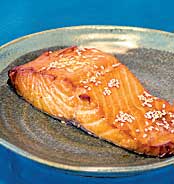 Â Should you eat more omega-3-rich fish for a healthier heart, or avoid fish because of contaminants, such as mercury?
 Should you eat more omega-3-rich fish for a healthier heart, or avoid fish because of contaminants, such as mercury?
Dr. Donald Hensrud, who is chair of Mayo Clinic’s Division of Preventive Medicine has posted his thoughts on MayoClinic.com. And, I found a useful link to safe seafood, state to state.
Dr. Hensrud is positive about fish. Based on the results of 2 large federally sponsored studies, he advises: “When it comes to a healthier heart, the benefits of eating fish usually outweigh the possible risks of exposure to contaminants.”
The main beneficial component appears to be omega-3 fatty acids in fatty fish.
- Improved cognitive (reasoning) function in developing children
- Decreased triglycerides
- Lower blood pressure
- Reduced blood clotting
- Enhanced immune function
- Reduced risk of stroke
- Reduced risk of dying from heart disease
What about the risk of eating contaminated fish?
- The main toxins in fish are mercury, dioxins, and polychlorinated biphenyls (PCBs).
- Pregnant women, women who can become pregnant, and children are most susceptible to the potential effects of toxins in fish.
- The amount of toxins depends on 3 things.
- The type of fish
- Where it’s caught
- How much you eat
The bottom line?
The Environmental Protection Agency has a web page that links to state websites, which contain listings of local safe an unsafe fish to eat.
States set up their sites differently. But with a little browsing you should be able to find the most up-to-date information. For example, the state of Maine has a quick reference poster. Alaska offers a “Fish Consumption Calculator.”
10/6/08 11:17 JR